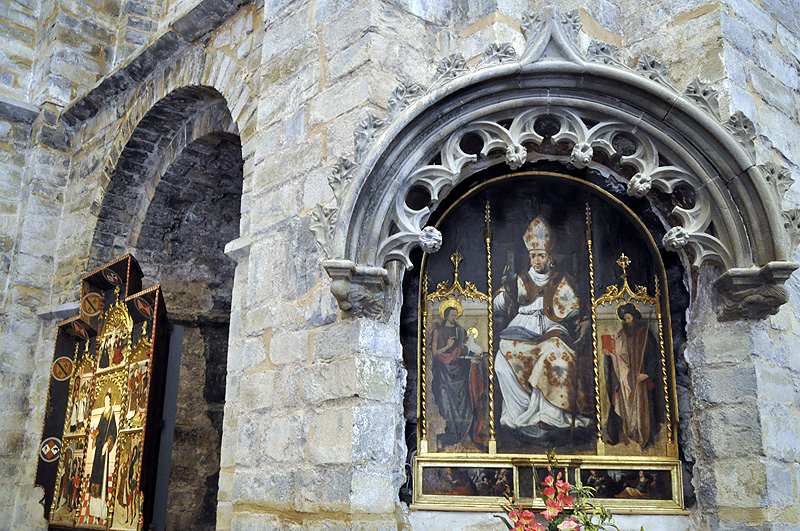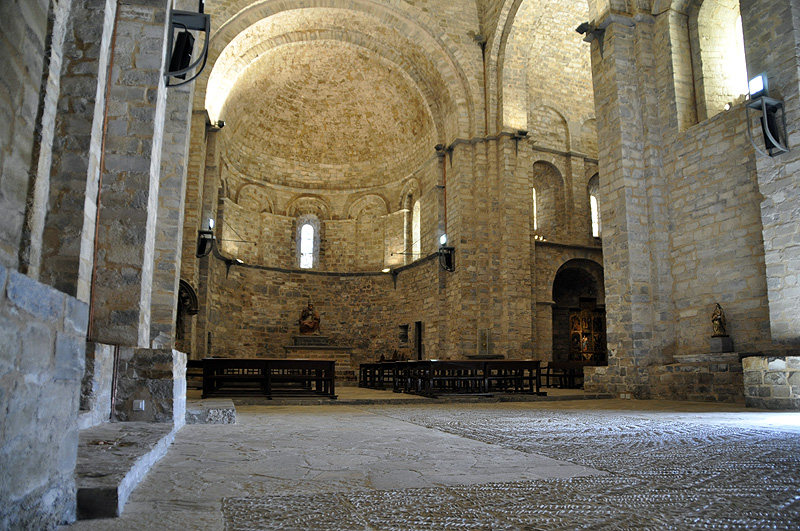Siresa. Church of San Pedro (St Peter). 9th to 13th centuries
The historic significance of San Pedro (St Peter’s) in Siresa is beyond all doubt. It is situated on the Roman way that crossed the Pyrenees over the “Palo” Pass and its beginnings are remote. It is known that a monastery of great importance and influence dedicated to St Peter existed here in the 9th century. The growing influence of other ecclesiastic centres, such as San Juan de la Peña or the cathedral in Jaca led to the transfer of monastic activities and the beginning of a period of decline, which was only slowed down by occasional building work.
Nonetheless, in the 13th century and coinciding with the definitive departure of the monks from the building, the last of two phases of restoration was completed, which was to alter completely its original appearance. As recently as at the end of the 20th century, the latest building project was carried out to substitute the groin vault with a barrel vault and incorporate a dome above the transept. The floorplan of the church is in the shape of a Latin cross with a single nave in three sections and a semicircular apse.
The external appearance of St Peter’s is impressive and its considerable dimensions reflect its past glory. Several blind semicircular arches cover the main body of the nave and the powerful buttresses accentuate its grandiose aspect. The entrance at the western end is noteworthy for its beautiful tympanum bearing the tradition monogram of Christ. The church and the stunning village of Siresa that surrounds it make up one of the most remarkable collections of historic buildings in the Jacetania area.
With regard to the interior, a 13th-century painted figure of Christ Crucified in wood is of special interest. It was found during the last restoration project in the altar of the southern transept. The altarpieces that decorate the church mostly date from the 15th century and were created by different artists of the Aragonese School. The sculpture of St Peter in polychrome stone, which originally belonged to the main altarpiece of the cathedral in Jaca (1604), also stands out. Popular accounts relate that the Aragonese king Alfonso I el Batallador (the Warrior) was christened in the baptismal font.
Nonetheless, in the 13th century and coinciding with the definitive departure of the monks from the building, the last of two phases of restoration was completed, which was to alter completely its original appearance. As recently as at the end of the 20th century, the latest building project was carried out to substitute the groin vault with a barrel vault and incorporate a dome above the transept. The floorplan of the church is in the shape of a Latin cross with a single nave in three sections and a semicircular apse.
The external appearance of St Peter’s is impressive and its considerable dimensions reflect its past glory. Several blind semicircular arches cover the main body of the nave and the powerful buttresses accentuate its grandiose aspect. The entrance at the western end is noteworthy for its beautiful tympanum bearing the tradition monogram of Christ. The church and the stunning village of Siresa that surrounds it make up one of the most remarkable collections of historic buildings in the Jacetania area.
With regard to the interior, a 13th-century painted figure of Christ Crucified in wood is of special interest. It was found during the last restoration project in the altar of the southern transept. The altarpieces that decorate the church mostly date from the 15th century and were created by different artists of the Aragonese School. The sculpture of St Peter in polychrome stone, which originally belonged to the main altarpiece of the cathedral in Jaca (1604), also stands out. Popular accounts relate that the Aragonese king Alfonso I el Batallador (the Warrior) was christened in the baptismal font.
Valle de Hecho Tourist Office . [ Jacetania ]
Also consult...
¤ Monuments
¤ Nature
¤ Villages
¤ Sport
¤ Tourist Offices
¤ Museums and Interpretation Centres
Guided tours 360°
Ciudadela de Jaca
[Español] · [Inglés]
Monasterio de San Juan de la Peña
[Español] · [Inglés]
Fort du Portalet
[Español] · [Francés]
follow us in...




 Comarca de La Jacetania
Comarca de La Jacetania
C/ Ferrocarril s/n 22700
JACA (Huesca)
T. (+34) 974 356 980
F. (+34) 974 355 241
:: Oficina de Turismo de JACA: 974 360 098
:: Oficina de Turismo de CANFRANC:
974 373 141
Site Map









